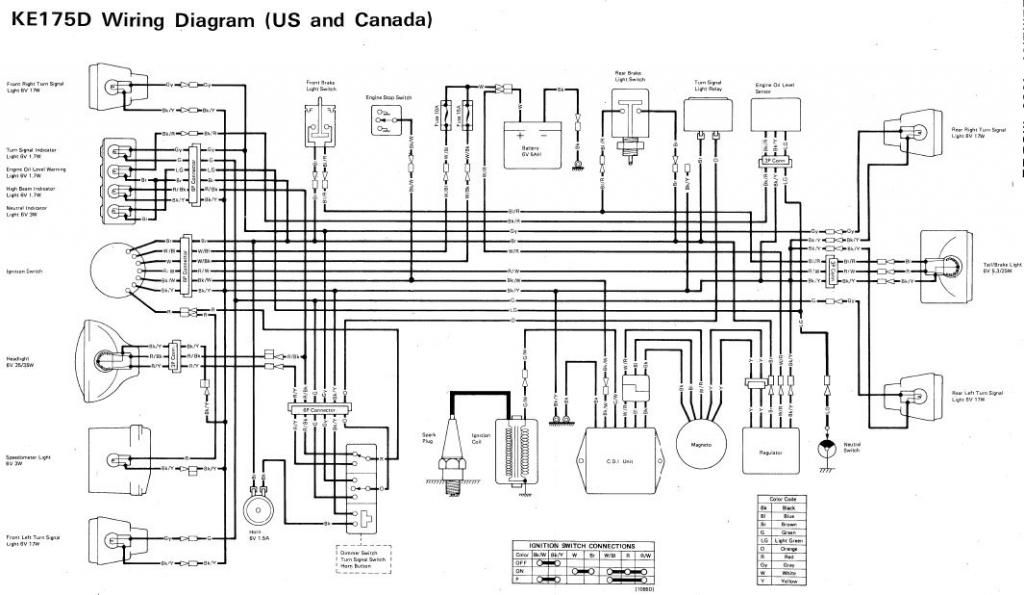Finally got sick of my KE175 turn signals being anemic. i.e. only working when revs are up and even then, not very bright. So I started poking around.
Poke around a little to see if there is anything obvious (warm wires, change in voltage when wires are wiggled, inspect a few electrical connectors) and scratch my head. Probably 1-2 minutes later, I look at the battery voltage..3.x volts! And I hear the battery sort of bubbling. I've heard a similar sound when charging batteries, but never when they're DISCHARGING! Seems to me that it almost acts like there's a short somewhere! I was going to put my meter inline on the current setting, but was afraid that the current was >10 amps.
For reference, the battery is a regular wet cell lead acid battery. Acid levels are good, and as far as age, I believe I put it in at the beginning of last season.
I figured I'd try checking for shorts. Here's what I did. There is one ground location for the electrical system, and another for the battery. The battery one is near the battery box, and the one for the electrical harness is located under the gas tank on one of the mounting screws for the coil. I disconnected the ground under the tank and measured the resistance from the ground strap to the frame to determine if it was shorted out anywhere else, or if this is the ONLY path to ground. With key ON, meter reads "OL". With key "off" it reads something like 3 M-Ohm. Pretty good so far. But when I put the turn signal on, it drops to 20-30 Ohms! Hmm!!! Not supposed to do that I don't think. Maybe it doesn't matter since the key was in the "off" position...no such change in resistance with turn signal switch movement when key was in the "on" position. Here's what the turn signal should be like...
(battery + terminal) <--W/Bk wire--> (ignition switch) <--Brown wire--> (turn signal flasher) <--Orange wire--> (turn signal switch) <--Green=left OR gray=right--> (signal bulb) <--Bk/y wire--> (ground eyelet at coil mount on frame below tank)
So my point there is that the ignition switch should isolate it the turn signal circuit in the off position, so turn signal or not, the resistance should be the same. In the off position, the only thing the ignition key does is ground the CDI unit, just like the kill switch on the bars does.
Any thoughts? Short circuit? Battery cooked? Electrical connectors? (plugged and unplugged most of them already...no apparent corrosion) Poorly designed electrical system? I'll try to post up the electrical schematic also.

- With engine off, I measured the battery voltage. 6.2 volts (it's a 6-volt system)
- Turned key on...drops to ~5.8 volts.
- Other lights come on as they're supposed to, albeit kinda dim (headlight, brake light, pilot light)
- Put the turn signal on...it is not flashing.
Poke around a little to see if there is anything obvious (warm wires, change in voltage when wires are wiggled, inspect a few electrical connectors) and scratch my head. Probably 1-2 minutes later, I look at the battery voltage..3.x volts! And I hear the battery sort of bubbling. I've heard a similar sound when charging batteries, but never when they're DISCHARGING! Seems to me that it almost acts like there's a short somewhere! I was going to put my meter inline on the current setting, but was afraid that the current was >10 amps.
For reference, the battery is a regular wet cell lead acid battery. Acid levels are good, and as far as age, I believe I put it in at the beginning of last season.
I figured I'd try checking for shorts. Here's what I did. There is one ground location for the electrical system, and another for the battery. The battery one is near the battery box, and the one for the electrical harness is located under the gas tank on one of the mounting screws for the coil. I disconnected the ground under the tank and measured the resistance from the ground strap to the frame to determine if it was shorted out anywhere else, or if this is the ONLY path to ground. With key ON, meter reads "OL". With key "off" it reads something like 3 M-Ohm. Pretty good so far. But when I put the turn signal on, it drops to 20-30 Ohms! Hmm!!! Not supposed to do that I don't think. Maybe it doesn't matter since the key was in the "off" position...no such change in resistance with turn signal switch movement when key was in the "on" position. Here's what the turn signal should be like...
(battery + terminal) <--W/Bk wire--> (ignition switch) <--Brown wire--> (turn signal flasher) <--Orange wire--> (turn signal switch) <--Green=left OR gray=right--> (signal bulb) <--Bk/y wire--> (ground eyelet at coil mount on frame below tank)
So my point there is that the ignition switch should isolate it the turn signal circuit in the off position, so turn signal or not, the resistance should be the same. In the off position, the only thing the ignition key does is ground the CDI unit, just like the kill switch on the bars does.
Any thoughts? Short circuit? Battery cooked? Electrical connectors? (plugged and unplugged most of them already...no apparent corrosion) Poorly designed electrical system? I'll try to post up the electrical schematic also.





Comment